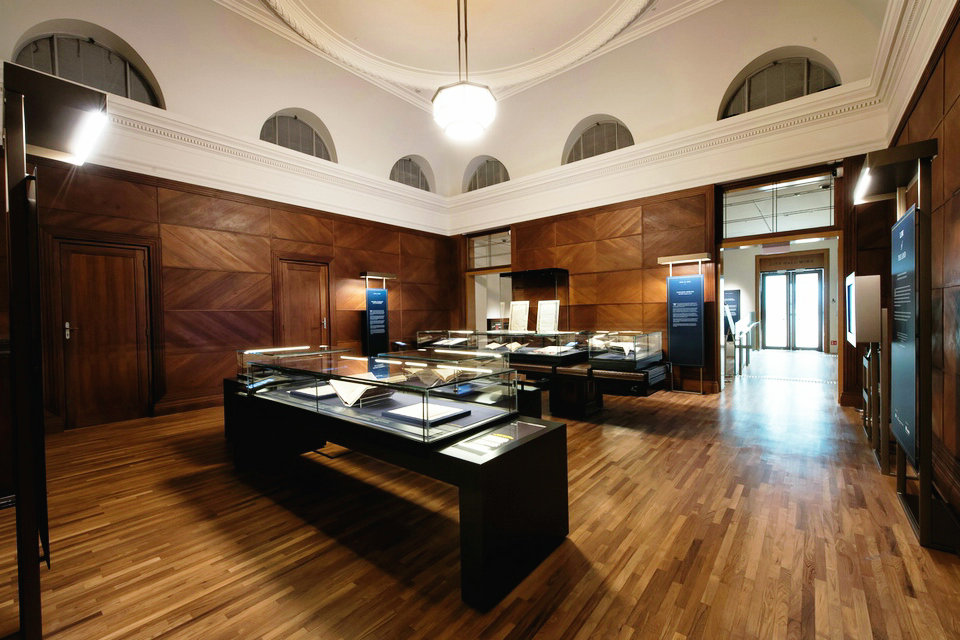Authority and Anxiety, Between Declarations and Dreams, Art of Southeast Asia since the 19th Century, National Gallery Singapore


Authority and Anxiety (19th to early 20th century): The section examines the birth of modern art in Southeast Asia in the significant social changes of the 19th century. Greater cultural contact with the West, often through the colonial experience, influenced the kind of art produced. Local elites used art to assert and defend their status, while artists asserted their cultural prowess by making use of new styles and techniques. The sense of a break from the past, or profound change, can be understood as the beginning of the modern.
The “Authority” part of the exhibition’s first theme sheds light on the cultural and aesthetic influences of colonialism and how they were not only used as propaganda, but also appropriated by local artists. Visitors begin their chronological journey in an elegant former courtroom, complete with spectator balconies and a dock.
Here, a fascinating miscellany of artifacts by both European and regional artists includes: finely wrought weaponry from Java; lithographs of detailed (if inaccurate) colonial maps; watercolor studies of Vietnamese royal court costumes; photographic ethnic studies of Javan “natives”; and miniature oils on ivory by unknown Chinese artists.
The definitive centerpiece is the large oil painting Forest Fire (1849) by Indonesian-born Raden Saleh. In his depiction of exotic jungle beasts fleeing from approaching flames, Saleh, who had at that point been living in Europe for two decades, conflates romanticism within the subtext of inexorable colonial power. Other works by this artist include two views of the Javanese Mt. Merapi erupting (both 1865) in violent landscapes that would have reinforced European preconceptions of a primitive land.
Further Western artistic influences are observed in placid portraits, such as that of a prominent middle-class Philippine family (c.1880s) by Filipino painter Simon Flores, which hangs alongside fellow countryman Félix Resurrección Hidalgo’s Christian Virgins Exposed to the Populace (1884), a salacious example of the mythical-historical narratives popular in Europe at the time.
Between Declarations and Dreams: Art of Southeast Asia since the 19th Century
What defines Southeast Asia and its art? From historical artefacts to contemporary perceptions of such objects, “Between Declarations and Dreams” traces the circuitous route of the region’s art, from its connection to 19th-century colonialism to its current reformulations of heritage, aesthetics and identity. The artistic journey through these galleries is a beautifully articulated progression, and the collection here establishes a lucid and distinctive framework for the Gallery’s fundamental aim: to advance the scholarly discourse on the history of Southeast Asian art. Given its detailed historical analyses and eclectic visual palette, “Between Declarations and Dreams” may best be savored over multiple visits.
Housed in the former Supreme Court building, the UOB Southeast Asia Gallery presents over 300 artworks that trace the shared artistic impulses across Southeast Asia. The UOB Southeast Asia Gallery, cultivate a deeper appreciation of Southeast Asia’s rich history and heritage and of developed as a region.
Starting in the mid-19th century, the exhibition navigates the art history of Southeast Asia as one that is characterised by a continuous encounter with the new as the regions artists negotiated the meaning of art and sought to reinvent vernacular expressions and aesthetics. Presented in a largely chronological sequence and punctuated by key turning points in artistic sensibilities, the exhibition also identifies how art is inseparably linked to the region’s tumultuous social and political history.
The title of the exhibition is credited to one of Indonesia’s most cherished poets, Chairil Anwar. In his poem of 1948, “Krawang-Bekasi”, Chairil Anwar laments the massacre of villagers in West Java by the Dutch colonial forces, giving vent to the desire for national independence at the time. This line may also be said to encapsulate the experiences of many artists in the region, caught as they are between declarations and dreams, the personal and the political.
The curatorial narrative explores four main themes places in a broadly chronological sequence, each one critically examining the shared artistic impulse of the region for each period: Authority and Anxiety, Imagining Country and Self, Manifesting the Nation, and Re:Defining Art.
This exhibition contains some artworks with potentially sensitive imagery. Visitor discretion is advised.
National Gallery Singapore
National Gallery Singapore is a leading visual arts institution which oversees the world’s largest public collection of Singapore and Southeast Asian modern art. Situated at the birthplace of modern Singapore, in the heart of the Civic District, the Gallery is housed in two national monuments – City Hall and former Supreme Court – that have been beautifully restored and transformed into this exciting 64,000 square metres venue. Reflecting Singapore’s unique heritage and geographical location, the Gallery aims to be a progressive museum that creates dialogues between the art of Singapore, Southeast Asia and the world to foster and inspire a creative and inclusive society. This is reflected in our collaborative research, education, long-term and special exhibitions, and innovative programming. The Gallery also works with international museums such as Centre Pompidou, Musée d’Orsay, Tate Britain, National Museum of Modern Art, Tokyo (MOMAT) and National Museum of Modern and Contemporary Art, Korea (MMCA), to jointly present Southeast Asian art in the global context, positioning Singapore as a key node in the global visual arts scene.
National Gallery Singapore oversees the world’s leading public collection of modern art from Singapore and Southeast Asia. It comprises over 8,000 works from the 19th and 20th centuries in all media, including painting, sculpture, printmaking, photography and video.
Aiming to be the centre for research, discussion and publication on the modern art of the region, the Gallery offers wide access and fresh understanding of our unique visual art heritage.
With its comprehensive collection, the Gallery presents the development of Singapore and regional cultures to tell their social, economic and political histories. The Gallery looks beyond national and regional boundaries of art to include a wider ambit of international visual arts culture, research into Asian heritage and cultural affiliations, and engage with global cultures and discourses.